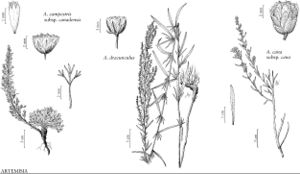familyAsteraceae
genusArtemisia
subgenusArtemisia subg. Tridentatae
speciesArtemisia cana
subspeciesArtemisia cana subsp. cana
Artemisia cana subsp. cana
Common names: Silver wormwood
IllustratedEndemic
Synonyms: Artemisia columbiensis Nuttall
Revision as of 20:47, 29 July 2020 by imported>Volume Importer
Shrubs, 100–150 cm. Stems white to light gray or brown. Leaves whitish gray, blades narrowly elliptic to lanceolate, 2–8 × 0.3–1 cm, usually entire, sometimes irregularly lobed, densely silvery-canescent. Heads in (leafy) arrays 10–20 × 5–7 cm. Involucres broadly campanulate, 3–4 × 3–5 mm. Phyllaries broadly ovate (mostly obtuse), densely hairy. Florets 10–20. Cypselae 1–1.2 mm. 2n = 54.
Phenology: Flowering mid–late summer.
Habitat: Sandy loam soils, often along streams
Elevation: 1000–1500 m
Distribution

Alta., B.C., Man., Sask., Colo., Mont., Nebr., N.Dak., S.Dak., Wyo.
Discussion
Subspecies cana is found primarily in the grasslands of Canada and the west-central United States. It is unusual within the species in that there is no morphologic evidence of hybridization with other species in subg. Tridentatae.
Selected References
None.
Lower Taxa
None.
... more about "Artemisia cana subsp. cana"
introrse +
connate +
truncate +
scarious +
ovate +
hirsute +
papillate +
absent +
continuous +
decurrent +
entire +
silvery-canescent +
lobed;narrowly elliptic;lanceolate +
stigmatic +
absent +
woody +
Silver wormwood +
resinous +
absent +
lacking +
resinous +
dimorphic +
fusiform +
1mm;1.2mm +
staminate +
staminate +
straight +
gland-dotted +
distinct +
proximal +
10;20 +
dispersed +
discoid +
indeterminate +
narrow +
Present +
surrounding +
campanulate +
alternate +
whitish gray +
deciduous +
deltate +
lobed +
scarious +
2-carpellate +
inferior +
attached +
anatropous +
persistent +
falling +
absent +
tough +
thick +
absent +
connate +
persistent +
distinct +
herbaceous +
falling +
hairy +
unequal +
Fl. Amer. Sept. +
1813 +
absent +
epaleate +
glabrous +
conic;convex;conic;convex;flat +
absent +
absent +
fibrous +
exalbuminous +
modifed +
4;7 +
alternate +
branched +
erect +
not wand-like +
2-branched +
glabrous +
papillate +
Artemisia cana subsp. cana +
Artemisia cana +
subspecies +
cylindric +
fibrous-rooted +
aromatic +
